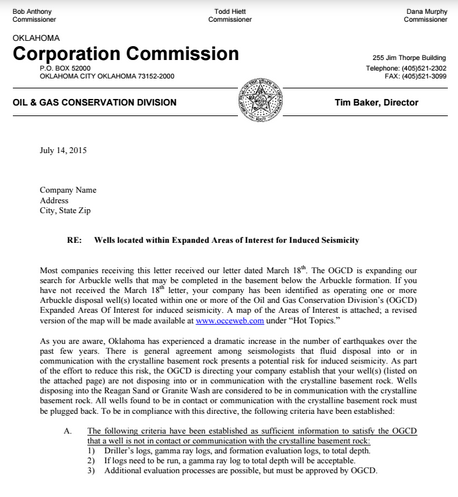
State Authorities Broaden Disposal Well Regulations in Earthquake-Prone Regions
-
Joe Wertz
Oklahoma oil and gas authorities are expanding regulations on disposal wells in earthquake-prone regions of the state. The orders, known as directives, were issued this week and broaden restrictions issued nearly four months ago.
The Oklahoma Corporation Commission in March ordered the operators of nearly 350 disposal wells to prove they weren’t injecting oil and gas waste fluid into granite basement rock, a known risk factor for triggering earthquakes.
Similar demands have now been sent to the operators of more than 200 additional wells. The crackdown comes as Oklahoma’s rate of earthquakes appears to be accelerating. In 2014, 585 magnitude-3.0 or larger earthquakes were recorded; as of July 17, 499 such quakes have been reported, data from the Oklahoma Geological Survey show.
“We’ve got to move forward as quickly as possible,” says agency spokesperson Matt Skinner. “Time is of the essence.”
The directive expands the size of seismically active regions that are under scrutiny, which are now present in 21 of Oklahoma’s 77 counties. The new regulations are also a little stricter than those issued in March, Tim Baker, manager of the commission’s oil and gas conservation division wrote in a statement announcing the directives.
“The directive we issued in March allowed some of the disposal wells to continue to operate if they reduced volume by 50 percent,” he writes. “Those operators are now being told they must reduce their depth if they are currently below the Arbuckle.”
The Arbuckle is a subterranean rock formation underlying most of the state that is a popular target for oil and gas disposal wells, a type of well scientists have linked to most of Oklahoma’s earthquake surge.
In a separate statement, Oklahoma Gov. Mary Fallin praised the regulatory effort and the assistance of the oil and gas industry.
“Reducing seismic activity requires a cooperative effort. The energy industry understands the need to protect homes and businesses and is voluntarily providing the Oklahoma Geological Survey and the Governor’s Coordinating Council on Seismic Activity with data and research assistance,” the statement reads. “The industry has also voluntarily cut injection rates at many wells. The state will continue to work with all parties to pursue sound, scientifically-driven policy to reduce earthquakes in Oklahoma and protect homeowners.”
